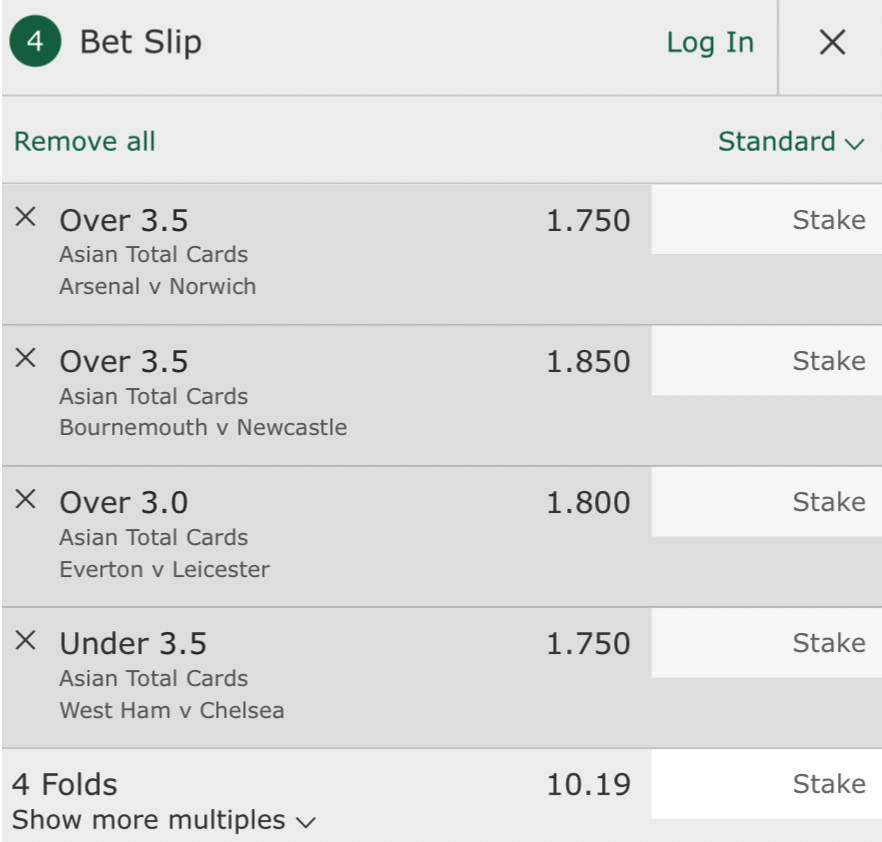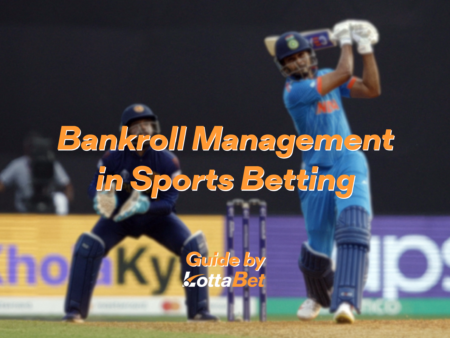A yellow and red card betting offers punters the opportunity to place bets based on the likelihood of a referee issuing a card during a sporting event.
Betting on Cards in Football: Cards Betting Guide & Tips
Table of Contents
Betting on Cards – Yellow & Red Card Betting
A yellow and red card betting offers punters the opportunity to place bets based on the likelihood of a referee issuing a card during a sporting event. Yellow cards are generally given for minor offences, while red cards are more serious and can lead to expulsion from the game. Both types of cards can affect the outcome of a game, so they offer an interesting way to add excitement to any wager.
What is Card Betting?
Yellow and Red Card Betting is a form of gambling that revolves around football matches. This type of betting is based on the players’ potential to receive cards, either yellow or red.
The odds are usually determined by the bookmakers before each game and they can vary considerably depending on the strength of both teams and also on how likely it is that one team will be more aggressive than the other. This form of betting has become increasingly popular among football fans in recent years and some online sportsbooks now offer special promotions for their customers who place bets on yellow and red cards throughout a season.
When placing bets on this type of market, it is important to consider several factors including form, individual players’ discipline history as well as other conditions like weather and pitch size which can have an impact on how physical a game becomes. Also, you should never forget about referee bias as this can play an important role when predicting which team will be shown cards more often than others during a match.
It is also wise to consult different sources in order to gain knowledge about certain teams’ playing style before placing your bets – doing so might give you an edge over other gamblers.
Card Betting Markets
Total Cards (Over/Under)
In Over/Under type of market, bettors are offered the opportunity to make predictions on whether there will be more or fewer yellow or red cards shown than what has been set by the bookmaker. This can add a real thrill to watching a match, as it allows you to potentially profit from predicting correctly how many cards will be shown.
Often, when placing a bet like this, bookmakers will offer short prices for ‘over’ bets if they think that more cards than predicted may be shown during the match. This can give savvy punters the chance to secure some good value if they think their prediction might be correct. For example, let’s say the bookmaker sets a total of 2.5 yellow cards for a particular game – if you think that 3 or more yellow cards will be issued, then you can back the ‘over’ at attractive odds which provides great value relative to how likely you think it is that your prediction will come true.
It is important however to remember that yellow and red card totals do not necessarily always reflect how competitively two teams are playing against each other as referees can sometimes take into account other factors such as player behaviour before making their decisions – something which should always be taken into account when placing bets on this kind of market. Furthermore, certain leagues may also have specific rules in place relating to how referees officiate matches and how many cards they are expected to show – so it pays to familiarise yourself with any potential regulations or guidelines which could influence your betting decisions for any given match or league.

Player To Be Booked
This form of betting is based on predicting which players will be booked during the course of a match. Booked players receive cautions in the form of either yellow or red cards, depending on the severity of their fouls or misbehavior.
A yellow card is generally shown to a player who commits an offense that directly affects play, such as a dangerous tackle. A red card is awarded when a player receives two yellow cards, or when they commit an offense which warrants immediate dismissal from the game, such as violent conduct. When betting on yellow and red cards, punters can place wagers on which players are most likely to get booked during the course of a match.
Player To Be Sent Off
These bets involve predicting which team or player will be sent off during the game.
The most common type of Yellow & Red Card Bet is when bettors guess which team will be the next to receive a red card. This typically refers to either the home or away side, although it can also refer to either one specific player or even a certain number of players from each side being sent off. This usually involves predicting whether there will be more than one red card issued during the game. Some bookmakers also offer special markets for predicting who will be shown the first red card of the match.
In order for a bet on a Yellow & Red Card Bet to pay out, it must be correctly guessed before any card has been shown by the referee. The odds offered on these bets vary wildly depending on how likely it appears that someone may receive a card, making them an attractive option for those looking to increase their stakes and potentially win big with minimal risk involved.
Card Handicap
In order to place a bet on card handicaps, bettors must first identify the likely outcome of a match when factoring in the number of yellow and red cards issued to each team. For example, if one team has more yellow cards than their opponents, then the odds may reflect that they are less likely to win or draw. Conversely, if one team has more red cards than their opponents, then it is much more likely that they will lose the match due to having fewer players on the field.
When placing a bet on card handicaps, bettors should also consider the teams’ form going into the match as well as any injuries or suspensions that may affect their performance. Additionally, they should take into account any potential referee bias that could lead to an excessive number of yellow or red cards being issued for either team during a match – for example, if a particular referee is known for issuing harsher punishments during matches involving certain teams then this could give one side an advantage over its opponents in terms of receiving fewer bookings and therefore potentially winning or drawing matches at higher odds than expected.
Asian Total Cards
Asian Total Cards betting involves betting on the number of yellow and red cards that will be shown in a soccer match. The bettor wagers on the total number of cards that will be shown in the match, regardless of which team the cards are shown to. This betting market is popular in Asia, hence the name “Asian Total Cards.”
In Asian Total Cards betting, yellow cards are worth 1 card and red cards are worth 2 cards. A bettor can choose to bet on the total number of cards being over or under a certain number, typically set at 2.5 cards. The odds will reflect the likelihood of the final number of cards being over or under that number.
Asian Handicap Cards
Asian Handicap Cards betting is a variation of Asian Total Cards betting, where the handicap is applied to the number of yellow and red cards. This betting market is popular in Asia and is designed to level the playing field between two teams by giving a virtual advantage or disadvantage to the team considered to be weaker.
In Asian Handicap Cards betting, the handicap is expressed as a number of cards, usually in half-card increments. The bettor can wager on the favorite team minus the handicap, or the underdog team plus the handicap. For example, if the handicap is set at -0.5 cards, the bettor can wager on the favorite team to receive fewer than 0.5 cards, or the underdog team to receive more than 0.5 cards.
In a match with a handicap of -0.5 cards, if the favorite team receives no cards, the bettor wins the wager. If the favorite team receives one yellow card, the result is considered a push, and the bettor’s wager is returned. If the favorite team receives two yellow cards, the bettor loses the wager. The same applies for red cards, but with a handicap of -1 card instead of -0.5 cards.
Card Betting Strategy
Specialise
This strategy is best used by bettors with an in-depth knowledge of the sport they are betting on, as well as teams and players they are betting on. It requires careful analysis of past results and current form, including individual player form, team dynamics and performances against certain opponents. By looking at all these factors, bettors can identify teams or players who are likely to pick up cards and use this information to their advantage when making their bets.
It is important to note that betting on yellow or red cards does not guarantee success – it simply increases the chances of being profitable. As such, bettors should diversify their bets across different markets such as correct score betting or handicaps to minimise risk. Betting on multiple outcomes also reduces variance over time which helps create long-term profits.
For those wishing to specialise in the Yellow & Red Card Betting Strategy, there are a number of resources available which will help them become more successful. Many bookmakers provide helpful statistics which can be used to identify potential opportunities while websites dedicated solely to this strategy provide detailed analysis of upcoming fixtures and recommended bets for each game week. With diligent research, patience and discipline, it is possible to make consistent profits using this strategy over time.
Know Your Teams and Players
The important step in the Yellow & Red Card Betting Strategy is to familiarize oneself with the teams and players involved in the game. This includes researching their past performances, including the number of red and yellow cards they have received in recent matches. It also requires observing individual players’ behaviour on the pitch, for example whether they are prone to early tackles or reckless challenges. Studying team dynamics can also be beneficial here; some teams may play more aggressively than others, or have different opinions on when a card should be issued.
When it comes to actually placing bets on matches using this strategy, it is important to consider both historical data and current form when making predictions. It is useful to look at how often certain types of fouls occur between two teams and the likelihood of those incidents resulting in a yellow or red card being issued. Additionally, consideration should be given to specific players; do they have a history of receiving cards? Knowing this information will help inform decisions regarding which type of cards are likely to be issued and when.
Certain Fixtures
In this strategy, a bettor selects an upcoming fixture that focuses on teams with high disciplinary records, as well as referees known for issuing cards. This gives the bettor a better chance at predicting which teams or players may receive yellow or red cards during the match. Betting on how long it takes for either team to receive its first card can also be profitable because these bets are fairly low-risk but have the potential of returning higher profits.
Additionally, it is important to consider other factors such as the expected lineups, recent form, and any possible injuries when selecting a fixture. A team that has several key players absent due to injury could be more prone to receiving cards, as they may struggle to keep up with their opponents’ pace of play while attempting to prevent fouls. The same goes for teams that have poor discipline in general and those with aggressive players who are known for receiving yellow or red cards regularly.
Finally, depending on which bookmaker you use, some may offer specific markets related to yellow and red card bets such as ‘Total Cards Market’ where you bet on how many yellow and/or red cards will be shown throughout the match.
Other bookmakers might also offer markets such as ‘To Card Home Team’ or ‘To Card Away Team’ which allow you to bet on whether or not either team will receive one or more cards during the game. By considering all these factors and researching carefully when selecting fixtures, punters using the yellow & red card betting strategy can increase their chances of winning in the long run.
Focus on Referees
This betting advice works by taking into account the referee’s style of officiating and his/her track record when it comes to handing out cards. By examining these two factors carefully, bettors can increase their chances of making profitable bets on the total number of cards given in a game.
When studying a particular referee’s style, bettors should pay attention to three main elements: the type of fouls that he/she usually gives cards for; the frequency with which they give cards; and whether or not they have any tendencies towards giving more red or yellow cards. It can also help to look at their history to see if there are any patterns in how often they have issued cards in past games. There may be referees who are particularly lenient or strict when it comes to handing out bookings, so this information can be invaluable for predicting future card totals.
Card Betting Tips
Card Stats for Players and Teams
Card stats are an important factor in considering a player or team’s likelihood of receiving a yellow or red card during a match, and information about these stats can help betters make informed decisions when selecting their bets.
When evaluating a player or team’s card stats, it is important to consider how often they have been called to task by referees in previous matches. This data can be found easily online and may include information such as the number of times one player has received a yellow or red card over the course of the season. It is also helpful to look at disciplinary records specific to the opposing team or individual players in order to get an idea of what kind of behavior should be expected during the match.
Additionally, bettors should pay attention to certain factors such as recent form, home/away status and players’ positional roles on the field since there may be more risk associated with certain positions than others.
Betting strategy may also come into play when considering card stats for betting purposes. For example, some punters may choose to wager on teams that get many cards per game due to their aggressive playing style while others may opt for sides that get few cards because they are better disciplined teams.
Similarly, bettors can use knowledge about opposing players’ discipline records in order to decide which bets offer good value and which ones should be avoided altogether. Some bookmakers even offer special markets dedicated solely to yellow and red cards so it is worth researching these options as well if a punter is interested in this type of betting style.
Card Stats for Referees
This form of betting involves looking at referees’ stats to determine how likely they are to issue these types of cards in certain matches. Stats such as average number of yellow and red cards per game, percentage of fouls leading to booking, or even card distribution tendencies by teams can all provide valuable insights into a referee’s behaviour which can help you predict when certain cards may be issued.
It is also important for bettors to take into account the level of competition being played in each match. Generally speaking, referees will be more lenient issuing yellow and red cards when playing at lower levels than they would in professional leagues due to differences in skill levels among players. It is also wise for bettors to keep an eye on any changes in referee duties from week-to-week as this could affect card distribution tendencies amongst different officials.
Finally, there are various other factors that go into making successful yellow and red card bets beyond just looking at referee stats; team form, player suspensions/injuries, home/away advantage etcetera all need to be taken into account before placing any wagers based on these statistics alone. By taking all these factors into consideration bettors will have a better chance at predicting when certain cards may be issued and ultimately increase their chances of success with their wagers on yellow or red card betting markets!
The Impact of VAR in the Modern Game
In general, VAR has made it more difficult for punters to accurately predict when cards will be awarded during a match due to its precision and accuracy.
Before VAR was implemented, there were smaller issues that could go unnoticed by referees such as minor fouls or ‘soft’ contact which would be ignored in certain games or by certain referees. This ultimately led to greater room for speculation when making card-related bets. With VAR now an integral part of football, these issues are no longer present due to more consistent officiating decisions. Additionally, incidents that may have previously gone unseen now can be discerned more easily with the aid of technology and video replays, allowing referees a second chance at catching any potential misdemeanours on the pitch.
Furthermore, card issuance rules and regulations have also become tighter since VAR has been introduced into football; with harsher punishments for repeat offenders or for incidents deemed worthy of being sanctioned. As a result of this increased rigour from match officials, bettors taking part in yellow/red card markets must be increasingly savvy about who they back when placing bets on the outcome or result of a given match – as any lapse in judgement could lead to them losing out on their wager.
Conclusion
Yellow & red card betting lets bettors make money based on the outcome of a match, as long as they accurately predict when a player will receive either a yellow or red card. Although it may seem like an easy way to make money, this type of betting can be risky and should only be attempted by those who understand the risks and have done their research on the teams involved in the match. Furthermore, due to the potential rewards that can be achieved with yellow and red card betting, more people are beginning to take advantage of this possibility each day. With careful study and analysis of the teams’ playing styles and past performances, a knowledgeable bettor can increase their chances of success while engaging in this type of betting activity.
Frequently Asked Questions
When to back Over/Under x cards?
When an attacking side is facing a defensive-minded team, there is usually less card activity in the game as the defending side may play more compactly and reduce their chances of receiving cards.
Which championships to choose?
Select tournaments that have a high frequency of yellow and red cards being issued during games. This could include popular leagues such as the English Premier League or La Liga, or even smaller divisions like Major League Soccer.
Which leagues produce the highest number of bookings per game?
It is typically leagues in Europe or South America that have the highest numbers of fouls and yellow cards.
Where to find Premier League card stats?
One of the best places to find comprehensive statistics for Premier League cards is on the official website of the Premier League.
Do 2 yellows and a red count as 3 cards?
Yes, 2 yellows and a red do count as 3 cards in football. While the accumulation of yellow cards may lead to suspension from the game, receiving 2 yellows and a red card is an immediate expulsion from the field.
Does a straight red card count as 2 cards?
A straight red card counts as two cards, meaning that the player who has been issued the red card will be sent off for the remainder of the match and also receive an automatic suspension for their next game.
- I-League Season 2023-24 – Final Results, Standings, Tables - April 18, 2024
- Cricket IPL Match Prediction – KKR vs RCB – Apr 21 - April 18, 2024
- Cricket IPL Match Prediction – DC vs SH – Apr 20 - April 18, 2024


















